






|
2006 |
 |
 |
 |
 |
 |
 |
 |
|
Picture of the Week (December 17): I came across this beauty on Kent Island, Maryland. And yes, one day I may write a small article on local equalization. Camera: Olympus E-500 Lens: 14-54 mm F/2.8-3.5 ZD at 22 mm (44 mm EFL). Exposure: Aperture priority (-0.7 EV), 1/320 s at F/5.6, ISO 100, WB at 5300K. Postprocessing in Photo-Paint: local equalization and a bit of tonal adjustment before and after that. (Click on the picture to see it in higher resolution.) |

|
|
It is this time of the year again: in a few hours I'm off for Poland, to enjoy the Christmas season there, and to sample this year's batch of the blackcurrant liqueur, lovingly prepared by my mother-in-law. While in Poland, I hope to set myself up a small wireless network, connected to the Internet, but — as always with networking — things may happen, so do not be surprised if I do not answer my email during that time. Back in Maryland on the first weekend of 2007. In the meantime, merry Christmas and happy New Year to all friends, regulars, and strangers visiting these pages (you may replace "Christmas" with generic "Holiday" here, if you wish, but this won't fool anyone). | |

|
Here is a casual snapshot from a visit to the National Gallery of Art in Washington, DC; it shows the Ill-Matched Lovers (~1520) by the Dutch master Quentin Massys. (For more on this painting, see the NGA page, where you will also find an "official" reproduction.)
The picture was shot handheld with an Olympus C-5050Z, no flash, no image stabilization (the camera has none). Program exposure with a |
|
As you may remember, I'm rather skeptical about image stabilization, be it lens- or body-based. A good shooting technique may give you more advantage in using slow shutter speeds, without the extra price in complication, cost, reliability, and image quality. Guess who provided me lately with new ammunition in this argument? There is a detailed review of the new Pentax K100D on the DP Review site, as always worth reading. Among others, the author performed a test of the body-based IS in that camera, with a honest and detailed description of procedures used, a rarity among reviewers in these days. Most importantly, the raw experiment data are given so that we can draw our own conclusions — if we know how. While the full results can be found in the text, let me just quote a few numbers. Without IS the K100D provided 5 (out of 10) subjectively sharp pictures and with IS — 8 out of 10, both at the shutter of 1/40 s. At the slower speed of 1/20 s, the results were 3 and 5, respectively, out of 10. (Lower and higher speeds did not show a difference, and the lens EFL used was 75 mm.) This is crying for a test of statistical significance. As both shutter speeds seem to show some improvement, I decided to merge the data, obtaining the so-called 2×2 contingency table: | |
| Sharp | Not sharp | |
|---|---|---|
| Without IS | 8 | 12 |
| With IS | 13 | 7 |
|
The 2×2 chi-square independence test (more accurate version, using the Yates' correction) results in χ2 = 1.604 for one degree of freedom. What does that mean? A quick look into chi-square distribution tables shows that there is a 20.5% chance of getting such, or more significant, difference just by a chance (for example, running with IS on or off in both series). If you want to check my numbers, the formula used was
with ni* and n*i being sums over i-th row or column, respectively, and n** — the grand total of 40. You may also go straight to a page on the GraphPad Software site; they have an online form, calculating exactly this test variable. Their results are consistent with mine. Mind it: I'm not saying IS does not work. What I am saying is that (a) these particular results do not prove an improvement in image stability at long speeds, and (b) any real improvement possible is a play of probabilities, not clearly visible in a particular body/lens combination at a given focal length. Most of reviews of IS-equipped systems do not even bother to check the feature, limiting themselves to just repeating manufacturers' claims (but not the pages of fine print accompanying these). About a year ago I heard somebody mentioning they had to re-run a similar IS test, as the first time "something went obviously wrong". What went wrong, most probably, was the big random number generator in the sky — they just had less luck than the reviewer whose data I'm quoting above. Will Olympus come up with an IS system in 2007? Most probably, yes. People hanging out in discussion forums will announce a national day of mourning if this does not happen. Not doing that would be a major PR disaster, regardless of technological significance. The crowds demand IS, the crowds will have IS. I couldn't care less. On the Olympus note, again: did you know that last year Olympus had the highest owner satisfaction level for cameras above $600, according to J.D. Power and Associates, the major source of such information. (It took John Foster to point this out in the September issue of Quest.) Cameras above $600? This may mean only SLRs, and this, in turn, clearly points at the E-500. Some of E-System camera users complain about high noise at the "optional" ISO settings of 800 and 1600. I was never really worried about this, as the "More ISO, more grain" metaphor was something I grew up with during the film era. Still, here is an article on the subject, with a comprehensive set of samples. In particular, I am investigating how the effect is reduced by activating the in-camera noise filtering or by using a third-party denoising application. Static (long-exposure) noise is also discussed. Not limiting myself to pixel-peeping, I decided also to print some of my samples. And yes, even at ISO 1600 you can get satisfactory 8×11" prints. Most surprisingly, however, it turned out that the random noise shows much less under incandescent light (as opposed to daylight). Have you ever discovered that your E-500 has been taking pictures using the Reference WB setting, although you could swear you've never set the camera this way? Welcome to the club! A new article describes the problem and how to work around it, or, at least, how to live with it. At the same time I went through the E-500 review, doing a major cleanup, fixing the remaining errors (just a few!) and adding whatever I felt was missing; a year in the making, this is the final release (except for possible minor tweaks, as usual). The E-500 sample page also was updated; more to come. Looks like I was wrong just three weeks ago, expecting that the recently announced Sigma lenses in the Four Thirds mounts would not be available until well into 2007 (my prediction was based on how long it took Sigma to come up with the previous batch of 4/3 lenses, announced last February). Lo and behold — just a few days ago I saw most of these lenses (except for the 150 mm Macro) listed by Adorama as available now. Interestingly, B&H is lagging behind in stocking up with the new Sigmas. Among those, the 300-800 mm F/5.6 takes the triple crown of the longest, heaviest, and most expensive Four Thirds glass available. Responding to complaints, Panasonic released a firmware upgrade to their L1 SLR, allowing new pictures to be taken while the contents of the buffer is still being written to the memory card. Importantly, the upgrade is installed from the memory card, with no need for the camera to be tethered to the computer. This is called common sense, and Olympus should pay attention, getting rid of the cumbersome procedure requiring the camera to be hooked to a computer running the Olympus Master software, and accessing the Internet. Why, for crying out loud, why? Is there intelligent life in advertising? I have serious doubts. A fragment of the press release for the new Tamron 18-250 mm zoom lens: "[The lens] provides an overwhelmingly impressive telephoto effect that is entirely different from the effect obtainable at 200mm on conventional high power zoom lenses." I must admit I am overwhelmingly impressed by the efforts of the copy writer, entirely different from anything obtainable with a conventional IQ above 60. (The remainder of the release is equally informative, if less entertaining.) In the last weeks I received a number of emails regarding the Four Thirds sensor size, and referring to claims that it is intrinsically inferior to the more popular APS-C frame. The Four Thirds Sensor Size and Aspect Ratio article is an attempt to clear the confusion by comparing the numbers and putting some facts together. For those who need help in choosing between raw and JPEG formats for saving their images, here it is: Raw Image Format: Pros and Cons in the Nitty-Gritty section (formerly: Technicalities). The bottom line: I find low-compression JPEGs good enough (and therefore preferable) for 95% of my shooting, but read the article to make your own decision; it may be different than mine. A company spokesman made a comment suggesting that Sigma may offer a Four Thirds SLR. This would be quite logical: the image frame of the current Foveon sensor used in the SA-14 is just 6% taller than that in Four Thirds, so the sensor could be used with no changes. For a number of reasons, I would consider such a step by Sigma beneficial to all parties involved. While I do not care much for the mock-up of the successor to the Olympus E-1, shown recently at the Photokina (see John Foster's comments on that), the news from the lens front are quite encouraging for Olympus SLR users. True, Olympus did not show any new glass this time, except for two economy, compact zooms aimed primarily at the E-400. Sigma, however, announced four new lenses in the Four Thirds standard:
I wouldn't expect any of these lenses to become available until well into 2007. Out of the Four Thirds lenses by Sigma announced last February, one is included again in the latest announcement, two became available only in September, and two (105 and 150 mm Macro) still have to show up. The Panasonic Web site shows another Leica-branded lens for the Four Thirds system: the 25 mm F/1.4 Leica D Summilux. No, the text does not expressly say the lens is already available, but the listing is right next to that of the L1 kit lens, and does not indicate anything to the contrary. My bet is on early 2007. To sum all this up: as of today we have three manufacturers offering lenses in the Four Thirds standard:
The Four Thirds lens list has been updated to reflect these developments; the accompanying text was also cleaned up. My favorite photo dealer, B&H, is closed on weekends (strictly Jewish!); when I tried on Monday, the 50-500 mm Bigma was sold out. My write-up will have to remain unfinished until they get it back in stock. In the meantime I may still change my mind, deciding to wait for the 135-400 mm mentioned above I would have to check the samples from cameras for which that lens is already available. | |||
|
The wait is over: the Bigma arrived to the States, showing up at B&H two days ago. In case you haven't heard: this is the 50-500 mm, F/4-6.3 tele zoom, now available in the Four Thirds (Olympus SLR) mount. With the maximum focal length equivalent to a 1000 mm lens on a 35-mm film camera, this is now the longest AF lens you can mount on your E-System camera. |
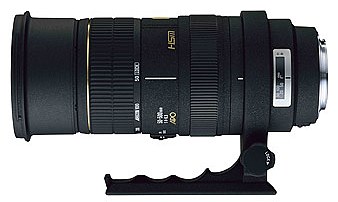
| ||
|
The Bigma is not for everyone. While the price ($1000) is rather a bargain for these specs, the 1000 mm EFL is barely handholdable (if you're lucky), depth of field is very shallow, and the weight of four pounds may be too much for many of us. All these factors are normal for such lenses; do not expect anything else. On the other hand, those shooting wildlife (including wannabees like myself) may put this lens to a good use, or at least try to. I'm getting the Bigma as soon as B&H re-opens after the weekend break; in time to enjoy it during the mild, beautiful Maryland autumn and an upcoming trip to Arizona. A full review should be expected when I'm back from the Saguaros; in the meantime here is a stub: just the specs and background information. Four times a year I receive a plain brown envelope from England, with the new issue of the Quest newsletter, published by the Olympus Circle. The last issue is as enjoyable as ever, almost evenly split between collectibles and digital, including my own Digital Corner column. This is the time when I make the piece from the previous issue available at this site; this time it is In Quest for a Digital Darkroom Application; the title is self-explanatory. If you are interested in Olympus gear, old and new, check John Foster's biofos.com site for subscription information (plus lots of related stuff). New today: a hands-on E-400 preview with lots of samples shot with a pre-production camera last Friday, courtesy of Łukasz Kacperczyk and the Polish fotopolis.pl site. I also posted my first remarks on the image quality in the E-400 commentary. The next day after mentioning the new Canon G7 I received two emails questioning my recommendation. Let me explain: Canon did a great thing not abandoning the high-end non-SLR market, and they now have the only camera in this class. What I am missing in the G7 is a tilting monitor, so useful in macro and tabletop shooting, and (maybe) an option of storing images in the raw format. Do I like it more than a C-5060WZ or C-7070WZ? Probably not, but I would have to spend at least a few weeks with the camera to really answer this question. Specs-wise, I consider the 10 MP sensor not much of an advantage over 6 or 7 MP of those models, especially taking into account the sensor size: 1/1.8" — that's 2.4× less than the Four Thirds sensor; an almost six-fold difference in area. I also don't care about stabilized lenses. Still, if you need a digital "rangefinder" camera without spending a five grand for a Leica M8, Canon is now the only choice (unless you go for a used camera).
September 17, 2006
The E-400 article has some additions and one correction: yes, there is going to be a wired remote for it, using the combo Video/USB socket. I just hope it will also work with the E-500. Thanks to the eagle-eyed Reader who spotted it in the E-400/E330 system chart.
Four Third lenses: I recently came across the Panasonic/Leica lens roadmap, showing, in addition to the already available 14-50 mm F/2.8-3.5 zoom, four more lenses: 14-150 mm F/3.5-5.6, 50-150 mm F/3.5-5.6, 25 mm F/1.4m and 45 mm F/2.0 Macro. The 14-150 and 25 mm are planned for early 2007, the two others perhaps a year later. All will have optical image stabilization. Keep your fingers crossed.
The new Canon G7. From where I stand, the most important pre-Photokina announcement (for us, mere mortals at least, who can only salivate looking at the new Leica M8) came from Canon. While it seemed that all significant participants (Canon, Nikon, Olympus) abandoned the advanced non-SLR market, Canon re-entered it, and in style, with their new G7. It has ten megapixels (more than it needs, I would think) and a 35-210 mm (EFL) zoom lens; plus a robust metal body and all adjustments you may need. Think the updated '5050, '5060, or '7070 (or the G6, which I liked, although not quite as much as these three). Most impressive.
| |||
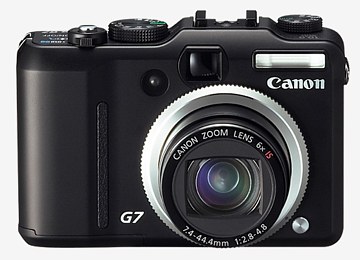
|
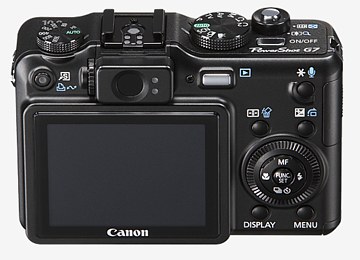
| |
| (Images by Canon Japan) | ||
|
Even if I don't care much about more pixels or stabilized lens (a 28 mm short end would be more valuable than that, even at the expense of less on the tele side), this shows Canon's resolve to support those who would like to shoot with something else than a reflex camera. If you are thinking of putting a rangefinder camera in your bag for those occasions when it is more handy than an SLR, Canon deserves a serious recommendation, and not only for being the only game in town. Have a look at the upcoming E-400 Olympus SLR. It is not revolutionary, just a downsized E-500, but the latter is a very attractive camera, so that the similarity is a compliment rather than criticism. Leica just announced the Digilux 3, another Four Thirds model. While this may look as a significant development, it is not: the D3 is just a re-branded Panasonic L1 with a different finish and some tweaks to the image-processing firmware. Yawn. More news over the weekend; now I have to catch some sleep... Olympus E-400: the Olympus Japan site posted a brief press release of this new model. Definitely, this is the smallest and lightest digital SLR yet. Body dimensions: 129.5×91×53 mm (E-500: 129.5�94.5�66 mm); body weight: 375 g (E-500: 435 g). Yes, 10 megapixels; major photo news sites have more details. So far the E-400 looks like the E-500, just smaller and lighter. More interestingly, two small and lightweight Zuiko Digital zoom lenses have also been announced:
This is just for the record; I'm going to comment on the camera's specs and compare them against the E-500 over the coming weekend, when I sort the detail out. | |
|
While still skeptical about xD-Picture cards, I decided to try the new, high-speed (Type "H") kind, so I ordered one at a hard-to-refuse sale price ($30 plus shipping), capacity of 1 GB. I've clocked its writing speed using my standard procedure, and the results have been added to the card writing speed article. Yes, on the E-500 the "H" card is twice as fast than the "regular", older-type ones. No, it is still not as fast as the SanDisk Extreme III, which is 2.5 times faster. A mixed answer for the '5060 (and, most probably, the '7070): while with these cameras the "H" card does not use the full speed it's capable of, it is still faster than any card I've tried, including the Extreme III. And no, it will not work with the '5050.
Should you buy one? If you are using an E-500 or C-5060/7070WZ, yes. You get an extra gigabyte of storage, available without opening the card compartment during a shooting session, and the writing speed is respectable, if not spectacular on the E-500; on the C-series, maybe the fastest available. The Rumor Department, continued: the first pictures of the new Olympus E-400 are floating around the Internet. The camera seems a tad smaller than the E-500 and is shown with a 14-42 mm (sic!), F/3.5-5.6 lens of compact size. It is also said to have a 10-megapixel sensor. My first guess: a mass-market offering, addressed at those who blame their not-so-good photographs at not enough pixels (read: 90% of the market). This does not mean that the camera has to be worse than the direct competition from Canon, Nikon, Pentax, or Sony; we should be not blaming manufacturers for making what the market wants. I hope it sells well enough to subsidize more ambitious and innovative offerings by Olympus. And, possibly, I yet may be wrong; we will see in a week or so. | |
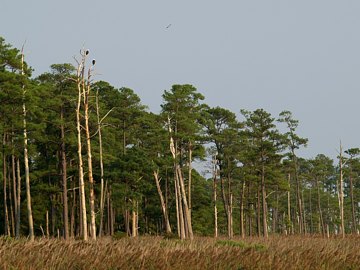
|
Last Sunday my wife and I went to the Blackwater National Wildlife Refuge near Cambridge, MD. We were able to spot a couple of bald eagles, perching on a dead tree overlooking the marshes, and watch them for a good twenty minutes. Not close enough for a good mug shot, though, even if I had a 50-500 mm Sigma telephoto zoom (which still seems not being offered by any U.S. merchant).
Olympus E-500, 40-150 mm ZD lens at 150 mm (EFL: 300 mm); aperture priority (-0.3 EV): 1/320 s at F/8, ISO 200, WB at 5300K; postprocessed in Corel Photo-Paint. |
|
Quite a busy Labor Day weekend: another significant expansion of Using Your E-500: new sections on external controls and on autobracketing. The Rumor Department. A quote from the Olympus Europe site: "E-300/E-500/E-330/E-400: TruePic Turbo" and "With the E-500/E-330/E-400, a continuous shooting until the end of the card capacity is possible [...] and then, on another page: "Ranging from 1/4000 sec. to 2 sec. in the program, aperture or shutter modes and up to 30/60 sec (E-300/E-1, E-500, E-330, E-400) in the manual mode [...]" E-400? This seems more than just a Freudian slip, three times in a row. The HTML of both pages carries update metatag of September 1, 14:35. Well, here it comes. Good news: Sigma Four Thirds lenses are not vaporware after all! Six months after the original announcement, they are becoming available, at least in Europe. The German Foto Koch site is currently listing the 18-50 mm F/2.8 (€374), 18-200 mm F/3.5-6.3 (€339), 30 mm F/1.4 (€379), 50-500 mm F/4-6.3 (€1199), 105 mm F/2.8 Macro (€429), and 150 mm F/2.8 Apo (€649), in addition to those already available for some time in the States. (Thanks to my Polish friend, Jerzy Wojewoda, for finding this out!) Now, let us see how soon all these will be available on this side of the pond. In the meantime, I have updated the Four Thirds lens list with links to Sigma's technical specs. The article on Depth of Field underwent another major revision: I've added some explanation on asymmetric lenses (hard to find in most sources), and all tables have been re-computed (not by hand: I wrote a program to generate browser-ready HTML code, and then only added some comments by hand). Yes, I've added the tables for the Four Thirds format, for focal lengths ranging from 11 to 500 mm. The mystery of broken plastic mount in the 14-45 mm ZD is solved: my respondent admitted goofing, this was the 17.5-45 mm ZD lens after all. Oh, well. Still, does anyone know where a replacement mount for this lens can be purchased? It is good to know that, after all, Olympus did not do the "silent switch" trick this happened in the past with other manufacturers (no names, please). So far the E-System has a very good track record, and I hope it to stay that way. | |
|
August 21, 2006 | |
|
It's been a long Sunday, but I have, finally, completed the Four Thirds standard zoom comparison, matching the 14-45 mm ZD lens with its 14-54 mm sibling, being almost twice as expensive. This is a long article, and if you just want to know the conclusions, here is the bottom line. |
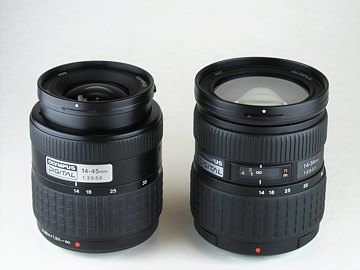
|
|
I still do not know what to do with the report of the 14-45 mm ZD lens with a black plastic mount (see the August 14 note below). Nobody else reported seeing one; on the other hand, known cases with a metal mount include serial numbers of 102028xxx, 102152xxx, 102324xxx, 102026xxx, 102285xxx, and 136215xxx. I suspect my respondent might really have the 17.5-45 mm lens, which, indeed, has a plastic mount, and he could have it confused with the 14-45 mm. I'm waiting for one more clarification from him. (See update of August 29.) A friend of mine asked for a recommendation of a compact, preferably clamshell, camera she could easily carry around, still capable of good results, allowing for easy exposure adjustments, and yes, with an optical finder. Her husband and son are using Olympus cameras, so she wanted to follow the suit. Surprise! Olympus does not make a single model fitting the bill, not any longer. The mass market does not care about optical viewfinders. Their FE series is a bunch of entry-level me-toos like those made by everybody else, and so is the Stylus line; besides, none of those have optical finders. The closest bet was the Canon SD700 Digital Elph (known as IXUS 800 in Europe), so I tried it out. While the camera delivers good images, I had to disqualify it: no exposure information, no direct access to exposure compensation; to adjust it you have to go through the menu system; thank you, no sale. What happened to the excellent Canon S-80, one of my favorite clamshell models, or to the Olympus C-7000 (a.k.a. C-70) which I also liked a lot, in spite of the zoom lens not wide enough? Not enough demand? Too expensive to make? Welcome to K-mart. Why optical viewfinder? Well, shooting with the camera pressed against your face gives you extra stability as compared to holding it in outstretched hand and using the LCD screen; I would estimate that at about 2 EV. Think of image stabilization without extra cost, complexity, and other downsides. Why exposure compensation? I believe this is a critical capability; none of the autoexposure systems I've tried are as good as you can be in bringing the scene tonality to where you want it, and this often changes from one shot to another. After I taught my wife (who is not technically minded) to do that, her results improved dramatically. Having to dig into the menus to adjust that is a major hurdle, enough to disqualify a camera in my book. | |
|
August 14, 2006 The last weekend my wife and I drove to the Eastern Neck National Wildlife Refuge near Chestertown, Maryland. We were glad we did; the place was almost empty, except for birds, including lots of ospreys and a young bald eagle (a few years ago I was able to approach a turkey vulture to get a good shot, but not this time). We had most fun, however, in the butterfly garden, beautifully exposed to late-afternoon sunlight at 6 PM, and the 40-150 mm ZD delivered some outstandingly detailed close-ups. Oh boy, do I like this lens! And it is practically given away with the E-500 kit. | |
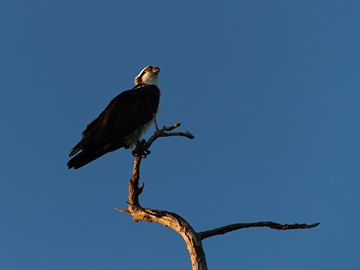
|
While the lens performs really good even wide open, I wish it could focus a bit closer, like to 1.2 m (not 1.8 m as it does); that would make it great for close-ups. It is also too short for easy bird shooting: here is a picture of an osprey, taken through the sunroof of my car. (It was cropped to 78% or 5 MP.) Close but no cigar. A 600 mm EFL would be just perfect!
Now you understand (and so does my wife) why I have to get the Sigma 50-500 mm zoom as soon as it finally becomes available (if it does). There are just too many birds around. |
|
A few days ago I received an email from a Reader reporting that the plastic lens mount of his 14-45 mm ZD lens failed. Plastic? I own two of these, and both have shiny, metal mounts. I asked for a re-confirmation, and my respondent did that: clearly, his lens has a black, plastic mount. Looks like in another "improvement" Olympus introduced this change (most possibly, earlier this year) without telling us about it, and without changing the lens denomination. And, to think of it, just last May I wrote the following comment in my article about infrared photography with the E-500: What I dislike, though, is that the whole operation was performed without a single warning or announcement. Many camera makers do that, not just Olympus; but I still think this is just wrong. If this is a common practice, then what will stop a less-than-ethical maker from economizing after the camera has been released, all tests and reviews published? Hey, we still have twelve megapixels, and you don't need to know that we switched to cardboard lens mounts! A kind request to the Readers: Let me know if (1) your 14-45 mm "kit" zoom has a black plastic mount; preferably include the serial number and purchase date; (2) you found a possible source for Olympus SLR replacement parts, which may carry lens mounts; this would help others facing a similar problem. (See August 29 for the conclusion of the story.) My long-time Internet buddy was able to put his hands on a retail Panasonic DMC-L1, and allowed me to quote verbatim his (mixed) impressions on that camera: Had a 10 hour layover in Osaka on Friday so I took the train into the southern shopping district of Namba. Headed to LABI1, a huge 5 storey electronics store. They had all the Digital Zuikos on display; quite a sight! There were two L1's on display that you can play with. The salesperson spoke very limited English so I couldn't ask too many questions. Brochure was in Japanese only. Price is Y249000, about $2264. Camera and lens sold as kit only and not available separately. My impressions: Camera is bulkier than I would like. Shape is not comfortable. The shutter release is in a very awkward position due to the protruding hand grip. It would be much better without the grip as in the old Minolta SLRs. They tried to do retro styling but added the grip which is not part of the old designs. Shutter noise is about the same as the E-330. Viewfinder is not as bad as many people claimed. It is not that much darker than the E300. Screen is very contrasty and manual focusing is quite easy. Manual focusing is very smooth and positive and feels like a mechanically linked focus ring though it is electronic. Better feel than the Olympus lenses. Mode B live view is inconvenient to use, just like the E-330. It is best suited to manual focusing. LCD screen is excellent. Info display is in large font and exposure compensation display is large and clear. Much better than the Olympus implementation. There was no SD card so the camera could not record the image. OIS seems to work pretty well when I attempted to shoot across the store displays. Camera displays image momentarily after shutter release but does not record - so I could not zoom in on the image to check for camera shake. Price is a little on the high side. Let's see what it sells for when we get it in the USA sometime in September. By then I hope Olympus will announce their new cameras, an E-1 replacement and hopefully some sort of intermediate camera like E30 perhaps. I think they could have made it more compact. Pentax *ist D is about the size of the E-500 but much more solidly built, with oversized mirror and all glass pentaprism resulting in larger, brighter viewfinder. Photokina should be interesting. I find this very informative, especially that I know and trust the writer's taste in cameras. Let us hope the L1 will carve itself a niche on the market, as it certainly deserves one. New articles this week: none! I'm too busy taking pictures. August 7, 2006 As you may remember, I'm not a big fan of proprietary memory card formats. Olympus (and Fuji) pulled a quick one on us once, having introduced, and then abandoned, the SmartMedia standard (a great name for a dumb card, i.e., one not including the controller; now the story is repeating itself for the xD-Picture format. The original xD-Picture card has been quietly replaced with two new types: xD-Picture "M" and xD-Picture "H", both offering greater capacities, and, in the "H" case, allegedly greater writing speed. The problem is that these new types are incompatible with some older (although not really old) cameras, like, for example, the compact C-60. For some cameras Olympus offers firmware upgrade making them compatible with the new cards, but no such upgrade is available for the C-60. To make things worse, Olympus no longer offers the "old" cards. Totally abandoning a camera model introduced just two years ago is not a nice thing to do. July 30, 2006 My new Nikon Coolscan V ED film scanner works very nice, thank you, in the 85% of cases when it feels that way. In the remaining 15%, sometimes randomly happening in a middle of an uniformly exposed negative film strip, the results are quite unpredictable and way off the mark (like the unexposed break between the frames coming up half-way up the luminance scale, or the whole frame hopelessly red). I suspect this is related to the stubborn refusal of the Coolscan V to perform self-calibration, signaling a hardware error every time I attempt that, and urging me to contact the Nikon service. Very sick on arrival? I'll keep you posted. The dusty E-500 (see July 6 below) has been returned to our Dutch friend by Olympus service in Portugal, alive and kicking. The camera was so clean, that Hans suspects the body might have been replaced (although the serial number remains unchanged); no smallest scratches or other traces of use. We'll never know... I'm still working on the standard zoom comparison, having added a section on optical quality, including a recompilation of the Olympus' MTF data on both lenses. That called for a new small article, an introduction to the MTF (Modulation Transfer Function). Also, braving a scorching heat today, I went to a nearby wildlife refuge and shot a series of comparative, side-by-side samples with both lenses, expecting to have them included in a few days; this should conclude the effort. The March issue of the Quest newsletter by the Olympus Circle carried my article discussing the unique viewing system used in the E-330. Here it is: It's All Done With Mirrors. |
|
New Gallery page: Anguilla Impressions. Usually I prefer my images "straight", i.e., without any significant manipulation in postprocessing. Sometimes, however, I get carried away, as some subjects like to be submitted to special effects, and here are the results. |

|
|
July 24, 2006 Back from Anguilla, back to work... This was a most relaxing and enjoyable vacation, and I brought back more than 600 frames shot with the Olympus E-500, which has proven itself very nicely. The C-5060WZ, which I brought along as a backup, never saw any action. One of the reasons is that I was shooting mostly with the ZD 14-54 mm zoom lens, which has quite good close-up capabilities, taking away the temptation to take out the '5060 for a quick macro shot. | ||
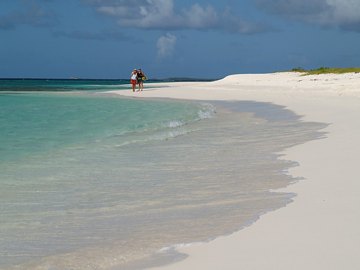
|
While I'm still postprocessing the Anguilla pictures, I already have enough keepers to post the first version of the Anguilla Gallery; you may want to have a look, especially to see what results the E-500 is capable of.
And yes, I'm very happy with the performance of the 14-54 mm ZD lens used for most of those pictures, although the work on updating the write-up of the Olympus "standard" zooms is not progressing at all: I'm too busy with other things. Have patience. | |
|
July 6, 2006 I just updated the firmware in my wife's Epson P-2000 Multimedia Storage Viewer, and took that opportunity to update its review with more measurements and remarks. It is sad to see a very good piece of hardware so crippled by inadequate software; unfortunately, the firmware upgrade does not address any of the flaws I have noticed; in particular, the device still does not support the Olympus raw image format. |
|
A Reader from the Netherlands reported his E-500 collecting dust underneath the monitor's protective glass cover, as shown in the picture. This is quite interesting, hopefully an isolated case I've received no other reports on this problem yet. The camera went to Olympus shop to be fixed. (Photo © 2006 Hans Dankers) |
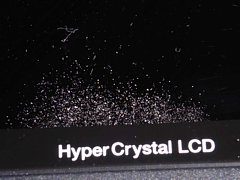
|
|
A suggestion to Olympus (and many other manufacturers): as a camera user I really appreciate the helpful captions, so nicely placed on your products, like HyperCrystal LCD shown in the picture above. I would like to see more of those, as they make cameras so much more enjoyable to use. What about Warm Touch Rubber on the eyepiece, Pitch Black Plastic on the body, or Real Metal next to each body screw? Oh, and don't forget all the helpful descriptions of camera's innards, like Mars III Image Engine and UltraCool Image Sensor: as my polls indicate, 95% of the users make their buying decisions based on careful inspection of the blister pack. The Four Thirds standard zoom comparison is slowly progressing; I have added a section on close focus capabilities, where the 14-54 mm lens has a clear advantage, and another one on vignetting. Still, a long way to go. Tomorrow I'm off for Anguilla in the Caribbeans. Having decided against bringing along two SLR bodies, I will be traveling light: the E-500, 14-54 mm and 40-150 mm zoom lenses, C-5060WZ without any accessories, a small tripod, and a few filters. No flash or laptop; my wife's Epson P-2000 will provide the space for offloading images off memory cards, if necessary. All of this will easily fit in the small Tenba Traveler P-506 bag (unfortunately, no longer available). I'll be back in a week; until then no updates to this site, and I'll be checking no email. See you then! | |
|
July 1, 2006 | |
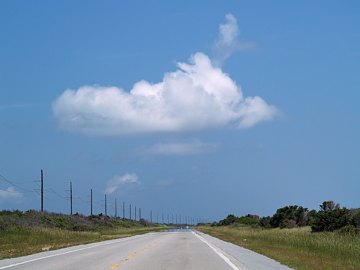
|
Going through my pictures from the last trip to Ocracoke, North Carolina, I discovered I have a large number of images from that island, taken in the last three years and never used. So here it is, a major update to my Ocracoke gallery, more than doubling its size. I hope you will enjoy at least some of them. |
|
Responding to quite a few requests by the Readers, I got down to comparing the "mid-line" 14-54 mm, F/2.8-3.5 Olympus zoom lens against its "economy" sibling, the 14-45 mm, F/3.5-5.6 zoom, which comes bundled with the E-300, E-500, and E-330. Being finally able to do some controlled-environment, all-other-things-equal shooting, I can now start drawing some conclusions. The full write-up will have to wait until I'm back from Anguilla, but at this moment I can already say that the 14-54 is, no doubt, a better lens, although the difference is not staggering, and many (perhaps most) users will be happy with the less expensive "kit" model. If you want to know more, see the preliminary version of the comparison article. Panasonic announced the price and release date of their DMC-L1 camera: coming this September at $2000. Ouch. The full announcement can be found at major photo news sites, like Steve's Digicams no surprises here. One fragment of the press release seems quite amusing. For your entertainment, let me quite it in extenso: When the camera is set to record at less than the maximum number of pixels, users can take advantage of an Extra Optical Zoom function. This function alters the 7.5-megapixel Live MOS sensor's operating area, to vary the angle of view and increase the maximum zoom ratio. Unlike a digital zoom, the Extra Optical Zoom function extends the focal length 1.5 times (when shooting at 3-megapixel or a lower-resolution mode) without degrading the image. Users enjoy extra zoom power without loss of picture quality. Excuse me? Using the central three megapixels of the 7.5 MP sensor is referred to as "optical zoom"? Throwing away 60% of the information "without loss of picture quality"? Somebody is trying hard to offend our intelligence. Successfully. (There is no loss compared to 3 MP mode, but this is still equivalent to cropping the image to the central part. Whatever we may call it, an "optical zoom" it is not.) |
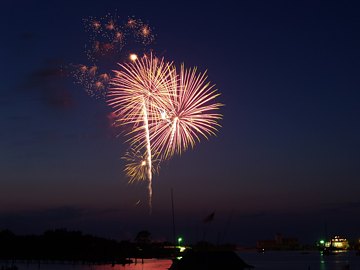
|
A reminder to the Readers from the U.S.: check out my firework shooting article, updated with some information relevant to the E-500; it may come handy this Tuesday, when you are watching the festivities. Most probably, I won't be shooting fireworks that day, getting ready my work stuff before the dash to Anguilla. Happy barbecuing! |
|
June 18, 2006 Yes, I'm back from Poland, except that I haven't spent much time working on these pages since coming back. First, we Slavs are supposed to be stereotypically lazy, and no degree of Americanization will help here. Second, I was busy taking pictures, including a trip to the Ocracoke Island in the Outer Banks, NC, over the Memorial Day wekend. Ocracoke is as enjoyable as always, and so are the sunsets over the Silver Lake harbor. Spending much time outdoors, I've done lately quite a lot of telephoto shooting with the E-500 using the two inexpensive lenses I have: the Sigma 55-200 mm F/4-5.6 DC and Olympus 40-150 mm F/3.5-4.5 ZD. To all those who keep asking: there is no doubt that the Olympus lens is better, if somewhat more expensive. It is sharper overal, in addition to being 2/3 EV brighter at the long end. I am also under an impression that the camera's AF system work better with it. The Sigma has 30% greater reach and will be OK for many applications (with a price hard to resist), but the Oly lens is better, giving me clearly superior results, especially wide open. In early July I'll be flying to a short vacation on the island of Anguilla in the Caribbeans. People say Anguilla has some of the most beautiful beaches in that region, and I just had a pleasant and entertaining email exchange with a photographer based there (hello, Susan, I hope you are enjoying your E-500!). Still, I was able to make some additions and/or corrections to a number of E-500 articles, and get another one ready: Focus bracketing in the E-500. You thought that feature is available only with manual focus, as stated in the manual? Wrong, you can use it retaining the AF as well. While in Poland, I picked up my IR-QA Angle Finder. I'm happy to say that the thing is well-made and works as advertised. Details can be found in the updated review. More stuff to come — when I find time to write it... May 7, 2006 I am now getting ready for my trip to Poland, leaving tomorrow; Ill be out of town for a week with limited access to the Internet, including email. While there, I am picking up the IR-QA angle finder, on which I already received three pieces of feedback from satisfied owners; one of those I'm quoting in extenso in the article. My own impressions to follow. I was quite busy lately, trying — no small deal — to streamline the way in which flights arrive to the busiest airport in the world. This is why I limited myself to modifying and expanding the existing articles, instead of starting new ones. Responding to a couple of requests, I've added program graphs for the two E-500 "kit" lenses to the Using Your E-500 article. Some readers may find this useful. The article is still being expanded and cleaned up. Having bought a two-gigabyte SanDisk Extreme III card, I decided to measure the writing speeds of the E-300 and E-500, with the results added to my card/camera benchmark article. The Extreme III write acceleration technology seems to work, indeed: expect about two seconds per image, be it raw ORF or JPEG. Surprisingly, the C-5050Z of 2002 is not far behind, writing a raw image in just three seconds, much faster than with the older breed of cards. This still is a small jewel of a camera, and I take it over any present-day rangefinder competition. Equip it with the newest 2700 mAh NiMH batteries from Maha (well, there is even a 2900 mAh model, but I trust Maha ratings more), and it will give a good run for the money to anything you can find on the market now. Speaking of batteries: what happened to Sanyo eneloop? (Yes, lowercase, don't ask me why!) Announced with much fanfare almost a year ago, these NiMH batteries were supposed to offer the best of both worlds: price and compatibility of NiMH AA's and freedom from self-discharge, like the Li-Ion chemistry. Last time I looked nobody in the States seemed to be selling them. Vapor-batteryware? From the email I'm getting, I can see a revival of interest in the venerable E-20. In spite of a five-year old design and specs, this camera can still hold its own against much of the newer competition, at least in most shooting situations, and, on the novelty-driven market, used ones often can be picked up cheaply. Some people also begin to realize, that a fixed-lens SLR may have some advantages, in particular, a complete freedom from the dust problem. And the live electronic preview is, I think, better and more hassle-free than in the new E-330 (of which I hear better-than-expected opinions). The continuing E-500 infrared story: three users reported findings consistent with mine (using the recent version); unfortunately, without serial numbers or purchase dates I cannot make any hypotheses about when the new anti-IR filter was introduced. For the record: the E-System firmware article has ben updated with the newest E-500 information. Some Readers report problems printing these articles for reference, with the right-hand part of text missing. This is not my fault: all browsers (with Microsoft Internet Explorer being, as usual, the worst offender) have difficulties in formatting text in tables — and I am using tables to define the text flow. Actually, Microsoft is listing this as one of the problems fixed in their upcoming Version 7! From my experience (including also Opera, my browser of choice, and Firefox), reducing the margins in the browser's print setup fixes the problem. The next update to these pages will show up in two weeks or so; maybe later if I'm really busy after coming back home. |
|
Picture of the Week (May 1): The Baltimore Inner Harbor, 2005. Camera: Olympus E-300 Lens: Sigma 55-200 mm zoom at 150 mm (300 mm EFL) Exposure: Program exposure (-0.7 EV), 1/250 s at F/6.3, ISO 100, WB at 5300K. Postprocessing: Perspective adjustment in Paint Shop Pro, tonal adjustment and sharpening in Photo-Paint. (Click on the picture to see it in higher resolution.) |

|
|
May 1, 2006 I just posted the new Picture of the Week, a view of the Baltimore Inner Harbor. Eagle-eyed Readers may notice that the image was postprocessed with use to two different programs: Paint Shop Pro to correct the perspective (about 2%; the camera had to point a bit upwards, and Photo-Paint to do everything else. (The TIFF format was used for transfer between programs to avoid double compression losses.) You may ask why: couldn't I do it with just one program? Yes, there is an explanation. But you will have to wait for it three months, as this is the subject of an article I wrote for the upcoming issue of the British Olympus Circle Quest newsletter, and those I reprint here only after the next issue is out. September, 2006: the article has been posted here. April 29, 2006 Last week I wanted to add another infrared sample to the article on IR photography with the E-500. What was intended to be a half-hour project turned out to be a two-day distraction. What happened? I just stumbled upon a production change in the E-500, introduced at some time between last October and March. As you remember, my E-500 was sent to Olympus for a shutter repair. After that, the IR sensitivity of the camera is about ten times lower than before. The details are given in the article, but everything makes me believe that the camera I received back has also a new, changed anti-IR filter in front of the CCD imager. Fact one: From the September '05 interview with Mr. Terada of Olympus published by Foto Imagen Digital: The low pass filter is the same but the Infrared filter is new. Now we are using a quite better IR filter, the same that you can find in some professional cameras. It is a really good component that will help to improve the image quality. Fact two: According to my October IR trials, the sensitivity of the E-500 to infrared remains the same as that of the E-300. The sensor remains the same, therefore the filter is not more restrictive. Fact three: Similar trials run in April, after my shutter assembly was probably replaced by Olympus, the IR sensitivity dropped by a factor of 10×. Meter indications (through the IR filter) remain the same. Most plausible explanation: The new filter did not make it to the early E-500 production runs (my camera was purchased on day one of availability), but it is being included into the current ones. The bottom line: Most probably the change is for the better (at least for most users, who do not shoot in infrared). Still, I don't it like when the makers introduce a change into the product without telling us about it. To quote from my article (which is of interest mostly to those who are thinking about IR photography with the E-500): Many camera makers do that, not just Olympus; but I still think this is just wrong. If this is a common practice, then what will stop a less-than-ethical maker from economizing after the camera has been released, all tests and reviews published? Hey, we still have twelve megapixels, and you don't need to know that we switched to cardboard lens mounts! One of the Readers reported being able to buy the elusive ME-1 eyepiece magnifier for the E-500/E-300/E-330 from Adorama. When I checked, they were out of stock again. Back to square one. | |
|
My angle finder accessory ordered from Poland has arrived to my wife's Polish address. She knows my taste in well-made instruments, and she says the thing is, quote, beautifully made. My friend and a fellow E-1 user from Poland, got one as well, and seems to be happy with it. |
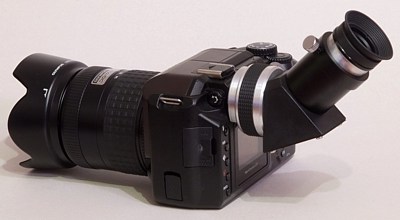
|
|
This is all I can say now, before I can actually try the device. I'm going to Poland the next weekend, so we will see. In the meantime, here is a preliminary version of the review, just the pictures and basic data, but no impressions, evaluations, or conclusions. This will be in place in two or three weeks, when I'm back in Maryland.
April 16, 2006 I'm still working on the Using Your E-500 article, and, frankly speaking, I'm learning quite a lot in the process, having to explore some features which I usually do not use, or use differently within my working habits. Still, I need another month or so before the article is where I want it to be. And, so far, no illustrations, which makes the piece a bit difficult to read. I have also updated Setting Up Your E-500, and both pieces now have a hyperlinked, detailed table of contents. Having used the E-500 with the bounced FL-36 flash at a recent party at my friends' place, I could see, once again, how the camera suffers from inability to use the built-in unit for a fill-in. While the ceiling-bounced light is quite soft and pleasing, the images lack the "punch" provided by the fill-in, softening the shadows. Next time I will use the E-300 for such purposes. And, yes, the finder: who would think that 10% in the finder image size makes such a difference? It does. The magnifying MA-1 eyepiece, promised by Olympus to be available in January, does not seem to be available anywhere. The Olympus Emporium online store is listing it, true, but out of stock. The same about the new Sigma lenses in the Four Thirds mount, announced two months ago. Come on, people, what will I do with my tax refund? April 9, 2006 My E-500 came back from the Olympus service center as good as new; the whole process, including transit in both directions, took exactly one week. Not bad. There was no comment included on what was done, but if the shutter is dead, it is dead. I would like to know if this is a pattern; if anyone experienced a dead shutter in this camera, let me know. Interestingly, I've sent the camera to Olympus with firmware updated to Version 1.1, and received it back with the original Version 1.0. Does this mean Olympus has problems with accessing the latest version of their own firmware? I wouldn't be so surprised, see below. Anyway, my older E-300 I was using in the meantime reminded me how good that camera really is, and while its controls are no match for the E-500 Control Panel, it is so nice to use a built-in flash as a fill for the bounced external unit... In the meantime, Olympus announced a v1.2 firmware upgrade for the E-500. I don't still know how it works, as my Olympus Master just reports being unable to connect to their server. My all Internet connections work just fine, I even removed the firewall just in case it was confused (it never was before), no good. I have tried for four days in a row, to no avail. I consider the system of firmware upgrading used by Olympus just a plain mistake. What would be wrong with a scheme (used, among other makers, by Olympus in the past) where you download the upgrade any way you please, copy it to a memory card, and let the camera sort it out? Actually, the Olympus Master software is also supposed to "upgrade itself" in a similar way, and it also refuses to do so. Once again, what would be wrong with providing just a simple install executable, which you could download in any way you please? Complicating things without a prevailing need is a bad thing, and I am not alone experiencing these problems. My advice to Olympus: re-assign the Einsteins who came up with this idea to some other work (like straightening old paper clips in the basement) and hire some 16-year old to bring things into shape. OK, if I sound angry, that's because I am. I don't like things which do not work. Who does? Update: Just as I was going to upload this to the server, I've tried again. This time both Olympus Master and the firmware were upgraded just fine. Obviously, the problem was with some scripts on the Olympus site. This does not change the validity of I just wrote above; expect soon a note on the new firmware. Over the last month I received quite a number of emails regarding my E-500 customization article. This mobilized me to finishing another one, on using this camera, while it is still quite raw (it usually takes a month or two to fill the gaps and iron out the wrinkles). I finally decided against buying the new E-330. While the camera looks very attractive, I think it may be better to focus on taking pictures than buying new equipment. And, somewhere in the back of my mind, I still have this thing against complicating things more then necessary... (Besides, I want to have a hands-on look at the Panasonic DMC-L1 when it comes out later this year. I may have to take a second mortgage, so what? On another front, I received three emails regarding the Olympus-Ritz riff (see the March 12 note below). All three, claiming insider information, say that a few years ago the owner/CEO of the Ritz chain discovered that Olympus was offering lower wholesale prices to some of the competition. To spare you details, the results are as you see them today: no Olympus at Ritz. Just a gossip? Maybe, but maybe not. The bottom line is what we can see, and this is a fact. March 12, 2006 The article on setting the E-500, posted last week, was well received, judging from the email I'm getting. Actually, in just a few hours after posting I've got the first messages (including those pointing out some typos; thanks! every little thing helps!). With things like this, I want to write a companion piece — notes on using and adjusting that camera in the field. (I wanted to write one for the E-300, but, let's face it, the E-500 is so much more fun to use!). In the meantime, my E-500 is going to Olympus to have the shutter fixed. Calling the technical service was a civilized experience: after going through the automated menu it took just 20 seconds for a live person to pick up the receiver, and in about three minutes I had the service information sent to my email address. (Yes, I timed the whole process.) Does anyone know what went sour between Olympus and Ritz Camera? About five (?) years ago digital cameras by Olympus disappeared from Ritz stores without any explanation (none on the Ritz site, either). I remember buying a number of Olympus film cameras from Ritz in the past, so both organizations certainly know about each other's existence, and at least budget models by Olympus are prominently visible in some other mass-market outlets. Oh, well. On the other hand, Ritz lists the Kodak Pro 880 as a "digital SLR". This follows the general trend — see some discussion groups, where "SLR" means simply "a camera with a hump". Life is cool, dude... More of the same? In addition to the big, painstakingly detailed, review of the E-500, I wrote another, shorter one on the some subject, for the December issue of the Quest quarterly by Olympus Circle. It is much shorter, and aimed mostly at film camera users. Now, that the next Quest out, I am free to post the mini-review here. I also largely rewrote my Depth of Field article, originally written in 2000 and updated just a bit since. In particular, a series of graphs have been added, giving a better idea of how DoF depends on various factors. In the meantime, the weather in Maryland is warm and mild: trees will be blooming soon; time to get a camera and do some shooting. | |
|
March 5, 2006 I just realized that my Web site is already ten years old: it goes back to November 5, 1995! Only in 1997 I posted the first pages on photography, though, and in 2000 started writing about Olympus digital cameras, starting from a detailed, technical review of the C-3000Z. Ten years is a long time on the Internet, with so many Web sites coming and going, and so many looking only after a quick buck. In case you want to have a look, here is the full story. Last week all photography enthusiasts were watching the yearly PMA show in Orlando, Florida, to see what new toys will this year bring us.
| |
|
Canon revealed the new EOS 30D camera with an I believe the evolutionary development of technology is a more natural way, only occasionally punctuated with revolutionary changes, with the Darwinian selection deciding which of those will fail or succeed. Sounds familiar? |
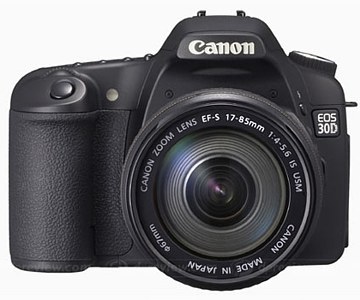
|
|
The new features in the 30D include some which the users of recent Olympus SLRs take for granted: a 2.5", high-resolution LCD screen, "picture styles" (image processing presets, of which the E-500 has five: three in color and two in monochrome), spot metering, and individual RGB histograms. All of these are welcome additions to a good and proven model, and I find it quite attractive at the $1400 (body only) price. | |
|
But the show was really stolen by Panasonic, unveiling a prototype of their first SLR, the Lumix DSC-L1. The camera, a cousin of the new Olympus E-330, shares with it some Olympus and Panasonic technology, still being quite different.
The L1 seems to be aimed at discerning, advanced amateur photographers, who will like its Leica-like feel, high build quality, external controls, and who can afford the expected price tag. |
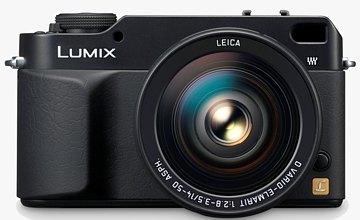
|
|
This starts looking like a pattern: major consumer electronic manufacturers are getting on the digital SLR bandwagon, teaming up with "traditional" SLR makers: in addition to Panasonic's bold move, Samsung entered the market with two re-branded Pentax *ist models, and Sony is expected to revive the operations of Minolta's camera division it took over — I would expect some big news from them soon. For those who believe (as I do) in the Four Thirds standard, the Panasonic announcement has even more importance, adding more credibility and promising more choice in terms of matching bodies and lenses from various manufacturers. The DSC-L1 comes with a Leica-branded, image-stabilized zoom lens of high quality, and it is expected that more Leica lenses will follow. At the same time, Sigma, a major independent lens maker, released five of their designed-for-digital offerings in the Four Thirds mount. While the previous Sigma 4/3 lenses were "economy" ones, these are mid-range. The new line-up adds a bright 30 mm, F/1.4 prime lens, which I find a very attractive option. No zoom means better optical quality, the focal length is equivalent to 60 mm on a film SLR (close to the "perfect standard" of 58 mm), and the wide aperture makes it very attractive in available-light photography. It also allows you to control the depth of field in a very effective way. | |
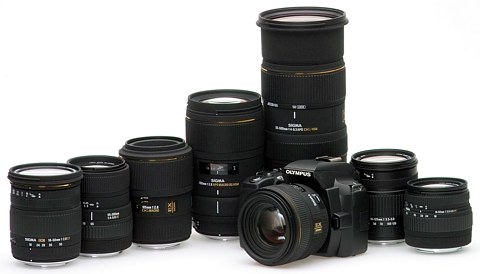
|
The line-up also includes 105 mm and 150 mm F/2.8 primes with macro capability (focusing from 31 cm or 38 cm, respectively), an 18-50 mm zoom with constant aperture of F/2.8. Bird photographers will be impressed with the longest zoom so far available for the Four Thirds system, the 50-500 mm, F/4.0-6.3, tipping the scales at just 1.83 kg (4 pounds). Remember, this is equivalent to 100-1000 mm on a film camera! |
|
The new Sigma lenses should be available shortly, as most are really mount modifications of ones already available in Canon or Nikon fittings for cameras with |
|
A new Gallery page: Khiva, Uzbekistan — monochrome pictures shot back in 1978. This was the time when, as a physicist, I traveled a lot in the Soviet republics of the Central Asia, and could have a closer look at that fascinating piece of the world. The pictures were shot on the East-German ORWO slide film (the best available east of the Iron Curtain), and that batch aged rapidly, with the colors degrading to the point of oblivion. Still, after converting the images to monochrome I realized that the tonality is quite good, and decided to show a few pictures here. |
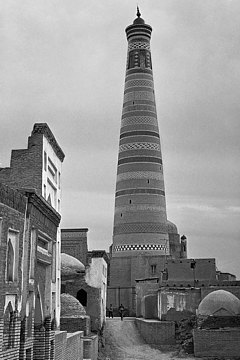
|
|
February 26, 2006 I have just posted a big piece on customizing the Olympus E-500, as promised, and a co-operative effort with Rafael Mill�n on the E-System VA-1 Angle Finder accessory. I am also in touch with the makers of a 45° angle finder for E-System cameras in Poland (see the article), as that offering looks quite attractive, too. February 5, 2006 |
|
I've been as surprised as anybody else with the Olympus announcement of the upcoming E-330 SLR, with the dual (optical and electronic) viewing system using a separate image sensor. That's quite radical, and you can read what I think about it (so far, at least), in a new article. |
.jpg)
|
|
On a wider front: Minolta (or Konica Minolta after the last merger) is out of camera business. Too bad; their film SLRs were my favorites for almost two decades, and the manual-focus XD cameras are still a delight to use. While Sony is taking over the Minolta SLR division, I'm not sure what will happen to the DImage line of film scanners; I was planning to buy one of those soon...
Also posted this week: updates to firmware information on January 30, 2006 Yes, I am back from Poland, having tried the Arctic winter there over Christmas and New Year. The bad news: one day before the New Year the shutter of my new E-500 simply stopped working. Everything else (metering, focus, mirror action) seems to be normal, except that the shutter just plain does not open. I hope this is just an isolated case; there are no signals of the problem being common. Anyway, I have to send the thing in for a warranty repair, using the E-300 in the meantime. I will keep you posted. |
 |
 |
 |
 |
 |
 |
 |
| Home: wrotniak.net | Search this site | Change font size |
| Posted 2006/01/30; last updated 2007/01/15 | Copyright © 2006-2007 by J. Andrzej Wrotniak |